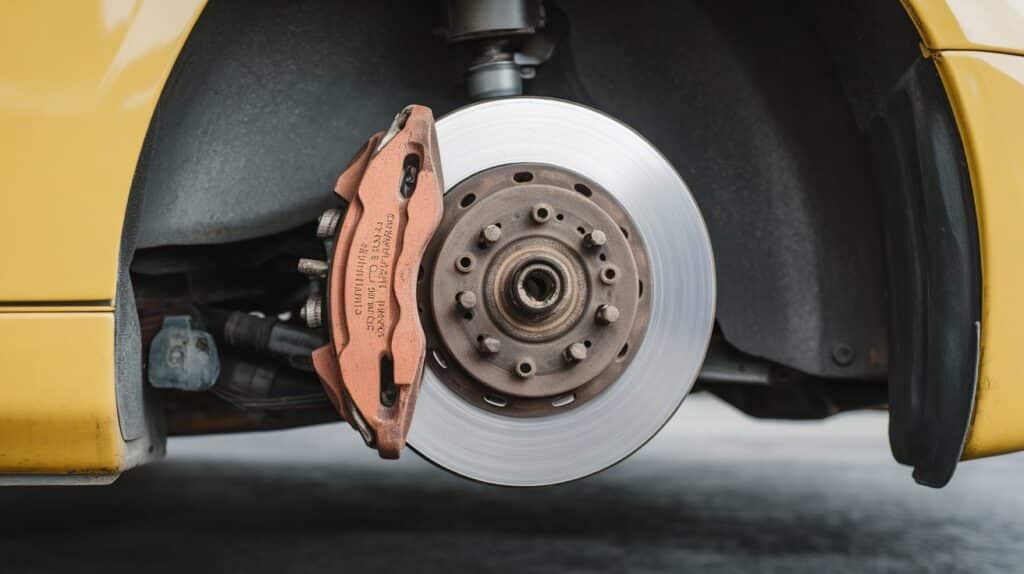Maintaining your vehicle’s braking system is crucial for safety, yet many drivers are unsure when to replace their brake pads.
This uncertainty can lead to compromised braking performance and potentially dangerous situations on the road.
Don’t worry – I’ll guide you through the key indicators that signal it’s time for new brake pads.
In this article, we’ll explore the unmistakable signs of worn brake pads, discuss the factors affecting their lifespan, and provide practical advice on brake maintenance.
By the end, you’ll be confident in recognizing when your brake pads need attention, ensuring your vehicle remains safe and responsive every time you press the brake pedal.
Here’s the content for the subheadings you provided, keeping all sub-subheadings intact:
Key Signs Indicating Replacement is Necessary

Brake pads are crucial to your vehicle’s braking system, which ensures your safety on every journey.
Recognizing these signs of worn brake pads is essential for preventing accidents and avoiding costly repairs.
1. Squeaking or Squealing Noise
- If you hear a high-pitched noise when applying the brakes, it often means the brake pads are worn out and need replacement.
2. Grinding Sound
- A grinding noise usually indicates that the brake pads are completely worn down, causing metal-to-metal contact.
- Immediate replacement is necessary to prevent damage to the rotors.
3. Reduced Brake Responsiveness
- If your brakes feel less responsive or the pedal feels softer than usual, it could be due to worn brake pads.
- This reduces your braking power and indicates that replacement is needed.
4. Brake Pedal Vibrations
- Vibrations or pulsations in the brake pedal, especially during braking, often indicate uneven wear on the brake pads or warped rotors, necessitating brake pad replacement.
5. Longer Stopping Distances
- If your vehicle takes longer to stop than it used to, it’s a sign that the brake pads may be worn out and need to be replaced.
6. Brake Warning Light
- Many vehicles have a brake warning light on the dashboard.
- If this light comes on, it could indicate that your brake pads are worn and need inspection or replacement.
7. Thin Brake Pads
- You can visually inspect your brake pads through the wheel spokes.
- If the pad thickness is less than 1/4 inch, it’s time to consider replacement.
8. Pulling to One Side
- If your vehicle pulls to one side when braking, it could be a sign of uneven brake pad wear or a caliper issue, which might require brake pad replacement.
Timely replacement of these components is key to maintaining optimal braking performance and overall vehicle safety.
Importance of Immediate Replacement
Recognizing the signs of worn brake pads is crucial, but understanding why immediate replacement is necessary can save you from potentially dangerous situations and costly repairs.
- Immediate replacement prevents further damage to the brake system
- Ensures safe driving conditions
Remember, it’s always better to be proactive than reactive when it comes to brakes.
Lifespan of Brake Pads and Rotors
Understanding the expected lifespan of your vehicle’s brake components is crucial for maintaining safety and planning for maintenance.
While brake pads and rotors have general lifespans, various factors can influence their longevity.
Typical Lifespan
- Brake Pads: Brake pads typically last between 25,000 to 65,000 miles.
- Rotors: Rotors generally last longer than brake pads, with a typical lifespan of 30,000 to 70,000 miles.
Factors Influencing Lifespan
- Driving Terrain: Hilly or mountainous terrain can lead to more frequent braking and increased wear on brake components.
- Weather Conditions: Extreme and wet temperatures can affect brake performance and wear rates.
- Personal Driving Style: Aggressive driving, frequent hard stops, and carrying heavy loads can all accelerate brake wear.
Consequences of Delayed Brake Pad Replacement
Postponing brake pad replacement can lead to serious consequences, affecting your vehicle’s performance and your safety on the road.
Understanding these potential outcomes can motivate timely maintenance and prevent costly repairs.
Impact on Vehicle Performance
- Slower Stopping Times: As brake pads wear down, they become less effective at creating friction, resulting in longer stopping distances.
- Increased Risk of Brake Failure: Severely worn brake pads can lead to complete brake system failure, especially in emergencies.
Potential Damage to Other Components
- Damage to Rotors: Worn brake pads can cause scoring or warping of the rotors, leading to uneven braking and potential rotor replacement.
- Impact on Tires: Uneven or worn brake pads can cause your vehicle to pull to one side when braking, leading to uneven tire wear.
- Strain on the Entire Brake System: Worn brake pads force other components, such as calipers and brake lines, to work harder, potentially causing premature wear or failure.
Actionable Steps to Maintain Brake Pads
Taking proactive measures and knowing when to seek professional help is crucial to maintaining your vehicle’s brake system.
By following these steps, you can ensure your brakes remain in optimal condition and address issues before they become serious problems.
Visual Inspections
- Regularly examine your brake pads through the wheel spokes for visible wear.
- This simple habit can help you catch thinning brake pads early.
- Make it a routine to visually inspect your brake pads monthly or during regular car washes.
Look for Changes
- Pay attention to any new sounds when applying your brakes.
- Early detection of squealing or grinding can save you from more extensive repairs.
- Make a habit of occasionally driving with the radio off to listen for brake noises.
Safe Driving Habits
- Avoid aggressive driving, sudden stops, and riding the brakes, especially in heavy traffic or on hills.
- These habits can significantly extend the life of your brake pads.
- Practice smooth, anticipatory driving by maintaining a safe following distance and looking ahead for potential stops.
Weight Management
- Avoid overloading your vehicle, as excess weight strains your brakes.
- Maintaining proper vehicle weight can help preserve brake pad life.
- Regularly clean out your vehicle and avoid carrying unnecessary heavy items.
Taking these action steps can significantly improve the longevity and performance of your vehicle’s brake system.
Conclusion
Don’t wait to hear that bone-chilling screech to think about your brake pads.
By now, you understand the critical signs indicating it’s time for a replacement: squealing noises, grinding sounds, and braking vibrations.
Remember, timely brake pad replacement isn’t just about maintaining your vehicle – it’s about ensuring your safety and that of others on the road.
Regular inspections, typically every 25,000 to 65,000 miles, can help catch wear before it becomes a hazard.
By staying proactive and attentive to your brake system, you’ll avoid costly repairs and ensure your vehicle stops reliably when you need it most.
So, when was the last time you had your brakes checked? If you’re unsure, it might be time to schedule an inspection.


